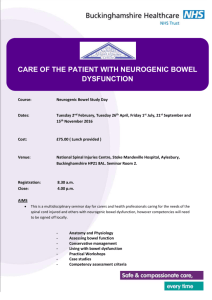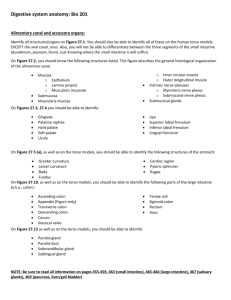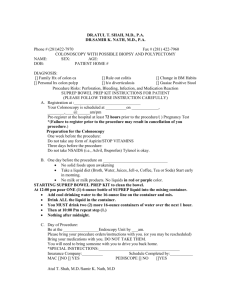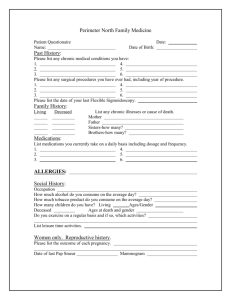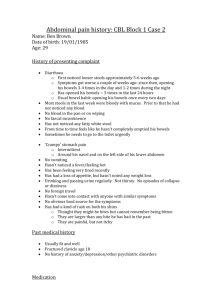CCP 63: Change in bowel habit
advertisement
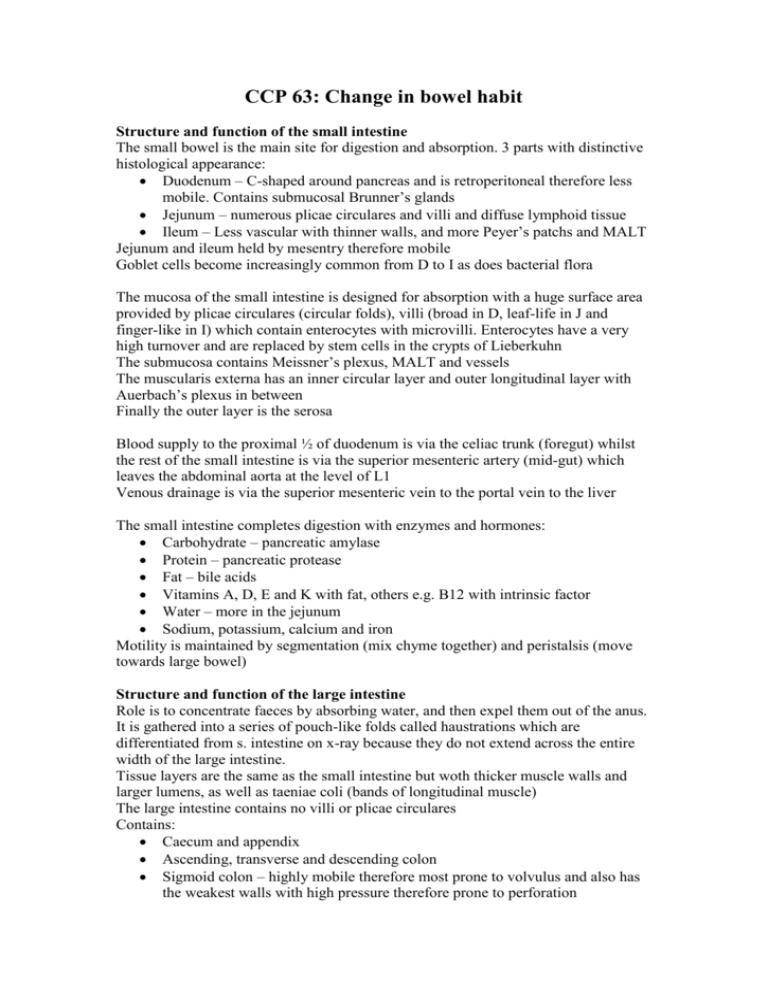
CCP 63: Change in bowel habit Structure and function of the small intestine The small bowel is the main site for digestion and absorption. 3 parts with distinctive histological appearance: Duodenum – C-shaped around pancreas and is retroperitoneal therefore less mobile. Contains submucosal Brunner’s glands Jejunum – numerous plicae circulares and villi and diffuse lymphoid tissue Ileum – Less vascular with thinner walls, and more Peyer’s patchs and MALT Jejunum and ileum held by mesentry therefore mobile Goblet cells become increasingly common from D to I as does bacterial flora The mucosa of the small intestine is designed for absorption with a huge surface area provided by plicae circulares (circular folds), villi (broad in D, leaf-life in J and finger-like in I) which contain enterocytes with microvilli. Enterocytes have a very high turnover and are replaced by stem cells in the crypts of Lieberkuhn The submucosa contains Meissner’s plexus, MALT and vessels The muscularis externa has an inner circular layer and outer longitudinal layer with Auerbach’s plexus in between Finally the outer layer is the serosa Blood supply to the proximal ½ of duodenum is via the celiac trunk (foregut) whilst the rest of the small intestine is via the superior mesenteric artery (mid-gut) which leaves the abdominal aorta at the level of L1 Venous drainage is via the superior mesenteric vein to the portal vein to the liver The small intestine completes digestion with enzymes and hormones: Carbohydrate – pancreatic amylase Protein – pancreatic protease Fat – bile acids Vitamins A, D, E and K with fat, others e.g. B12 with intrinsic factor Water – more in the jejunum Sodium, potassium, calcium and iron Motility is maintained by segmentation (mix chyme together) and peristalsis (move towards large bowel) Structure and function of the large intestine Role is to concentrate faeces by absorbing water, and then expel them out of the anus. It is gathered into a series of pouch-like folds called haustrations which are differentiated from s. intestine on x-ray because they do not extend across the entire width of the large intestine. Tissue layers are the same as the small intestine but woth thicker muscle walls and larger lumens, as well as taeniae coli (bands of longitudinal muscle) The large intestine contains no villi or plicae circulares Contains: Caecum and appendix Ascending, transverse and descending colon Sigmoid colon – highly mobile therefore most prone to volvulus and also has the weakest walls with high pressure therefore prone to perforation Rectum Anus Blood supply is from the superior mesenteric atery (mid-gut) up until the distal 1/3 of the transverse colon which is supplied by the inferior mesenteric artery (hind-gut) The large intestine flora contains many species of bacteria which defend against pathogenic bacteria, a process easily disrupted by administering antibiotics. The flora also convert conjugated bilirubin to urobilinogen and then to stercobilinogen to be excreted in the faeces Colonic mucosa contains many goblet cells which secrete mucus to lubricate the colon and therefore prevent trauma. Motility of the large intestine occurs via segmentation and peristalsis and is controlled by sympathetic (decreased motility) and parasympathetic (increased motility) activity Index conditions Colorectal carcinoma The second most common cancer in the UK, and more common in the western world due to diet high in animal fat and low in fibre leading to slow transit time in the intestine. Risk factors include familial polyposis coli and inflammatory bowel disease The cancer is caused by a series of genetic mutations including the APC tumoursuppressor gene on chromo 5, K-ras and p53. Classified using the Duke’s classification: A – confined to bowel wall B – Extends through muscularis propria but not lymph nodes C1 – All layers affected including proximal lymph nodes C2 - Higher lymph nodes affected Histologically, signet ring cells are also seen due to excess mucin production Hereditary non-polyposis colorectal cancer (HNPCC) is an AD condition where the cancer develops from flat adenomas – occur by age of 40 Symptoms of large bowel cancer Altered bowel habit with loose bowel motions the most common Anaemia, weight loss, abdo pain Left-sided lesions (i.e. rectosigmoid) rectal bleeding/obstruction Investigations: FBC for anaemia Faecal occult blood Barium enema and flexible sigmoidoscopy Management Surgical resection with end-to-end anastomosis Dukes B and C – chemotherapy and/or radiotherapy Screening – for those aged 60 – 74, faecal occult blood test every 2 years and positive results are referred to colonoscopy Inflammatory Bowel Disease Inflammatory response to environmental conditions, usually in genetically predisposed individuals Increased risk of colonic cancer Ulcerative Colitis Limited to colon Bloody diarrhoea, Colicky abdo pain, urgency, tenesmus Extra-intestinal manifestations: Eyes – uveitis, conjunctivitis, episcleritis Bile buct – sclerosing cholangitis Bones – ankylosing spondylitis Joints – Seronegative arthritis Skin – Erythema nodulosum, pyoderma gangrenosum Investigation – endoscopy with mucosal biopsy: Superficial, continuous ulceration Crypt abscesses Barium enema – ‘lead-pipe’ colon IBD is a relapsing-remitting disease – flares are often caused by environmental factors which may cause inflammatory response to bowel flora. Non-smoking, NSAIDs and stress are causes The most worrying complication is toxic megacolon – severe inflammation involves the smooth muscle leading to paralysis and dilatation of more than 5cm on x-ray Management – the aims of management is induction and maintenance of remission: Corticosteroids during flares e.g. oral pred 40mg per day If ineffective – use azathioprine Mesalazine – maintain remission If UC is affecting QoL or not responding to treatment, colectomy is indicated Crohn’s Disease Involves anywhere from mouth to anus, most commonly terminal ileum and proximal bowel Abdo pain and weight loss, but may cause colonic symptoms Extra-intestinal manifestations Investigation – CRP correlates to disease activity. Endoscopy and biopsy: Patchy transmural ulceration and skip lesions Granulomas Complications include strictures, abscesses and fistulae. Crohn’s has a stronger genetic component than UC and is more common in smokers Management – colonic disease management is the same as for UC Bowel resection for strictures Toddler’s diarrhoea Persistent loose stools in a well, thriving child Caused by a delay in intestinal motility with intermittent, explosive ‘carrots and peas’ diarrhoea The diarrhoea will ease with age or from addressing the diet of the child Irritable Bowel Syndrome Can be diarrhoea or constipation – predominant, or present as a mixed picture. Typically presents in women aged 20-40 Symptoms RIF abdo pain – relieved by defecation/flatus Abdo distension and feeling of ‘bloating’ Anxiety/depression Diagnosis is clinical, and management involves reassurance (that the disease will not progress to a more serious condition) and lifestyle advice Bacterial infection is the most common cause of diarrhoea worldwide – especially travellers! Usually spreads faecal-oral route and contaminated food. Symptoms are diarrhoea, abdo pain and fever/vomiting Investigations – FBC may show leucocytosis. Stool culture. Common pathogens are E. coli, shigella and salmonella Management is with rehydration and appropriate antibiotics C.difficile is responsible for outbreaks on hospitals, particularly after antibiotic treatment and in elderly – treated with metronidazole or vancomycin


